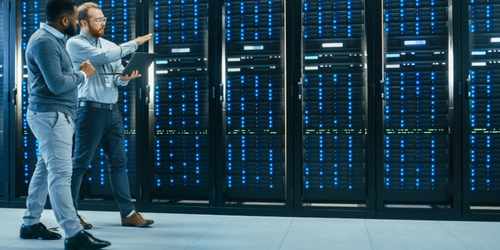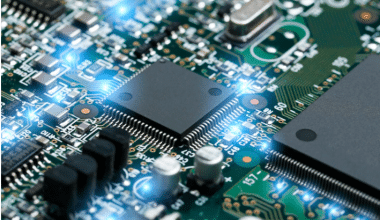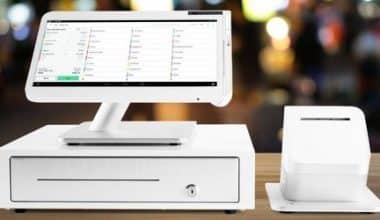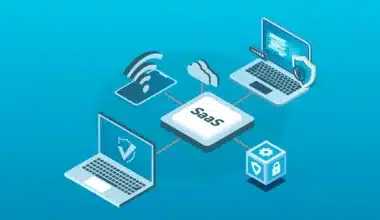A data center, in its most basic form, is a physical structure that corporations utilize to host their vital applications and data. The design of a data center is built on a network of computing and storage resources that allow for the delivery of shared applications and data. In this article, we will carefully analyze all there is about a data center including its types, what a data center network is, who a data center technician is, and the comparison between a data center vs cloud, among others. Let’s get this party started!
What Is a Data Center?
A DC is a physical building that houses the computing power to run programs, the storage capacity to process data, and the network that connects employees to the resources they need to execute their jobs.
Although experts believe that on-premises data centers will be supplanted by cloud-based alternatives, many firms have concluded that they will always have applications that require on-premises storage. The DC is developing rather than disappearing.
Edge data centers are popping up to process IoT data, making it more scattered. It is being upgraded to run more effectively by utilizing technologies such as virtualization and containers. It is introducing cloud-like capabilities like self-service. In a hybrid arrangement, the on-premises DC is merging with cloud resources.
Once exclusively available to large enterprises with the necessary space, resources, and personnel, data centers now come in a variety of configurations, including colocated, hosted, cloud, and edge. In all of these cases, the DC is a locked-away facility, noisy and cold, that keeps your application servers and storage devices safe to do their thing 24 hours a day.
Why are Data Centers Important?
Every firm requires computing equipment to run web applications, provide customer services, sell items, or run internal accounting, human resources, and operations management programs. The scope and number of required equipment develop dramatically as the business and IT activities expand. It is difficult to maintain equipment that is spread across multiple branches and locations. Instead, businesses utilize data centers to consolidate their devices and manage them more efficiently. They can also use third-party data centers instead of maintaining it on-site.
Data centers provide various advantages, including:
- Backup power supplies are used to deal with power outages.
- Disaster recovery requires data replication across several machines.
- Temperature-controlled facilities to extend equipment life
- Easy implementation of security measures for data compliance
What does a Data Center do?
DCs are an essential component of any corporation, supporting corporate applications and providing services such as:
- Storage, management, backup, and recovery of data
- Email and other productivity applications
- E-commerce transactions with a high volume
- Providing support for online gaming communities
- Machine learning, artificial intelligence, and big data
There are apparently more than 7 million data centers in the world now. Every corporate and government institution either produces and maintains its own model or has access to someone else’s, if not both.
Types of Data Centers
There are various types of data center facilities, and a single corporation may use more than one, depending on workloads and business requirements.
#1. Enterprise (on-premises) data centers
This is one of the types of a data center. All IT infrastructure and data are hosted on-premises in this DC approach. Many businesses prefer to have their own on-premises data centers because they believe they have greater control over information security and can more easily comply with regulations like the European Union’s General Data Protection Regulation (GDPR) or the United States Health Insurance Portability and Accountability Act (HIPAA). The company is in charge of all deployment, monitoring, and management responsibilities in an enterprise DC.
#2. Public cloud data centers
Cloud data centers (also known as cloud computing data centers) store IT infrastructure resources that can be shared by various customers—from a few to millions—via an Internet connection.
Major cloud services providers such as Amazon Web Services (AWS), Google Cloud Platform, IBM Cloud, Microsoft Azure, and Oracle Cloud Infrastructure run many of the largest cloud data centers, known as hyper-scale data centers. In fact, the majority of the world’s biggest cloud providers operate multiple hyper-scale data centers. Cloud service providers typically maintain smaller, edge data centers that are closer to cloud clients (and cloud customers’ customers). Edge data centers can assist minimize latency for real-time, data-intensive workloads including big data analytics, artificial intelligence (AI), and content delivery apps, boosting overall application performance and customer experience.
#3. Managed data centers and colocation Facilities
Managed data centers and colocation facilities are solutions for enterprises that lack the capacity, people, or knowledge to deploy and operate some or all of their IT infrastructure on-premises but do not want to host that equipment utilizing the shared resources of a public cloud data center.
In a managed data center, the client company rents dedicated servers, storage, and network gear from the DC provider, and the DC provider handles the client company’s administration, monitoring, and management.
The client company owns all of the infrastructure in a colocation facility and leases a dedicated space to host it. The client company has sole access to the gear and entire responsibility for managing it in the classic colocation model; this is great for privacy and security but often unworkable, especially during outages or emergencies. Most colocation providers now give administration and monitoring services to clients who want them.
Remote data backup and disaster recovery technology for small and medium-sized enterprises are frequently housed in managed data centers and colocation facilities (SMBs).
Defining the Modern Data Center
Data centers have changed dramatically in recent years as enterprise IT demands has shifted toward on-demand services. Nowadays, it is said that the modern DC is where your workloads are.
Enterprises are modernizing their data centers with modern architecture to support this level of application elasticity and mobility. To serve application workloads anywhere, a modern data center relies on virtualization, the cloud, and a software-defined network; this covers physical data centers as well as multi-cloud and hybrid systems.
A modern infrastructure enables your company to expand into cloud services. This advancement in a data center provides flexible scaling for spikes in network, storage, and computing demand.
What are the Components of a Data Center?
Every DC has the same underlying infrastructure, which allows for consistent and reliable performance. The following are the fundamental components:
#1. Power
To keep equipment functioning around the clock, data centers require clean, dependable power. A DC will have numerous power circuits for redundancy and high availability, with backup provided by UPS batteries and diesel generators.
#2. Cooling
Electronics generate heat, which, if not managed, can cause device damage. To avoid overheating equipment, data centers are designed to pull heat away while delivering cool air. This intricate balance of air pressure and fluid dynamics necessitates the consistent positioning of cold lanes where the air is pumped in and hot aisles where it is collected.
#3. Network
Devices within the data center are interconnected so that they can communicate with one another. Furthermore, network service providers give connectivity to the outside world, allowing access to enterprise applications from any location.
#4. Security
A dedicated data center provides a level of physical protection considerably beyond what can be accomplished when computer equipment is placed in a wiring closet or another area that was not explicitly intended for security from the bottom up. Equipment is carefully tucked away behind secured doors and kept in cabinets with protocols to ensure only authorized workers can access the equipment in a purpose-built data center.
Data Center Support Infrastructure
Data centers are vital assets that require a strong and dependable support infrastructure that includes power subsystems, uninterruptible power supplies (UPS), backup generators, ventilation and cooling equipment, fire suppression systems and building security systems.
Organizations such as the Telecommunications Industry Association (TIA) and the Uptime Institute have developed industry standards to aid in the design, building, and management of data center facilities. Uptime Institute, for example, defines these four tiers:
- Tier I: Basic capacity; a UPS is required.
- Tier II provides redundant capacity as well as redundant power and cooling.
- Tier III: Continuous maintenance assures that any component can be removed from service without disrupting production.
- Tier IV: Fault-tolerant, allowing any production capacity to be protected against ANY form of failure.
What is the role of AI in the Data Center?
Algorithms may now play the conventional Data Center Infrastructure Manager (DCIM) job, monitoring power distribution, cooling efficiency, server workload, and cyber threats in real-time and making efficiency adjustments automatically. AI can reallocate workloads to underutilized resources, detect possible component problems, and balance pool resources. It accomplishes all of this with little human intervention.
What is a Data Center Technician
A data center technician is a computer hardware specialist who assists in the installation and maintenance of data servers and network equipment. They frequently have in-depth knowledge of data center infrastructure as well as the capacity to troubleshoot any technical issues that may develop. A data center technician is frequently in charge of a company’s servers and networks. They can monitor these systems to ensure that the computer equipment and programs are operating properly and securely.
To become a data center technician, you must first grasp how a firm, a data center, cloud services, and data management work. A data center technician with a bachelor’s degree in computer science or networking is frequently preferred by employers. This is a physically hard profession that may entail moving heavy equipment, working with cabling, and working irregular or extended hours.
Data Center vs Cloud
The primary distinction between the public cloud vs a data center is the location of data storage. Data is typically housed on your organization’s premises in a data center. Certain data centers may be in places that your organization does not own—in this situation, your data center is colocated but not in the cloud. The cloud is fully off-site, and your data is accessible via the internet from anywhere.
The majority of their differences include:
#1. The cloud is unsafe
This is one of the most prevalent cloud fallacies, and it was one of the most significant barriers to cloud adoption in the early days. Many wrongly concluded that because data or services were moved to the cloud, the cloud was less secure because others could access it. Currently, most people understand that this isn’t always true.
When it comes to security, most cloud providers actually outperform data centers since they have specialists that handle the security, management, and maintenance of the servers and infrastructure used.
#3. Data centers are prohibitively expensive to run
The cloud has the potential to be less expensive and more efficient, but this is not always the case. You will not always receive the same level of service from one vendor as from another. Furthermore, the cost of using cloud services varies depending on the time of day, consumption, and other factors. Hence, while shifting to the cloud may be cost-effective for certain firms, it may incur additional costs for others, especially if the migration is not carefully planned or if they demand a huge amount of bandwidth.
Data Center Security
In addition to the building security mechanisms outlined above, A data center network requires a full zero-trust analysis to be incorporated into any DC architecture. Datacenter firewalls, data access controls, intrusion prevention systems (IPS), WAF, and their modern counterpart Web Application & API Protection (WAAP) systems must be appropriately designed to guarantee they scale as needed to meet the demands of data center networks. Furthermore, while selecting a data storage or cloud services provider, it’s critical to understand the security precautions they employ for their own DC. Invest in the highest level of protection available to keep your data safe.
Collaboration with a data center security provider is an excellent strategy to achieve these objectives. Check Point Maestro provides on-demand hyper-scale protection to fulfill an organization’s data center security needs.
What are Examples of a Data Center?
DC services include the following:
- Hardware installation and upkeep.
- Managed power distribution.
- Backup power systems.
- Data backup and archiving.
- Managed load balancing.
- Controlled Internet access.
- Managed E-mail and messaging.
- Managed user authentication and authorization
What are the Three Types of Data Center?
Data center are composed of three major types or components: compute, storage, and network.
How do Data Centers make Money?
Operators of data centers generate money by leasing or licensing power and space.
What are the top 5 Largest Data Centers in the World?
The following are the most notable DCs located around the world:
- China Telecom Data Center.
- China Mobile.
- The Citadel Campus.
- CWL1 Data Centre.
- Apple’s Mesa Data Center.
Who needs Data Centers?
Data centers are required by every business that generates or consumes data, including government agencies, educational institutions, telecommunications firms, financial institutions, retailers of all kinds, and providers of online information and social networking services such as Google and Facebook.
What is the Difference between Data Center and Server?
A DC is a self-hosted deployment. The key technical distinction between Data Center and Server is that Data Center allows numerous application servers to execute in parallel. The server only allows one application server.
Conclusion
A data center is a physical site that often houses essential IT and computing services and infrastructure. To put it another way, a DC is a physical location where data is stored and computed. This post has succeeded in describing everything you need to know about a data center, and if you want to turn this into a job as a technician, this guide is a fantastic place to start.
Related Articles
- CUSTOMER CALL SERVICE: Duty, Quality, Types, and What to Know
- 21 Best CALL CENTER PHONE SYSTEMS & Reviews in 2023 (Updated).
- Cloud Technology: Beginners Guide to Cloud Technology Solutions
- CALL MANAGEMENT SYSTEM: How it works
- ERP SYSTEM: Meaning, Examples, and Top 5 Picks
- DOMESTIC WIRE TRANSFER: How It Works
- FINANCIAL STRESS: How To Deal With It






